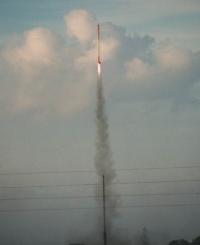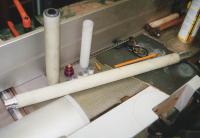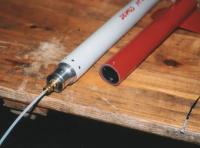Deimos PTV1 composite hybrid successful!
 In the aftermath of the cancellation of the Deimos Odyssey launch and the
launch of the 'ADV2' rocket by our 'rivals' Aspire Space to just under
5000ft (after three years of development) Ben Jarvis decided that MARS
should make an amateur hybrid vehicle to launch at the K-Lob launch and set
a new amateur altitude record. Having just proven the performance of the
aluminised 'Sparky Concern' fuel grain in static tests of the BK-Flamer
motor it was decided that a small motor using this fuel would be a viable
option. If the new fuel wasn't enough this flight was also to be the first
test of a fully composite hybrid propulsion system in the UK. The Deimos
'Propulsion Test Vehicle 1' was born.
In the aftermath of the cancellation of the Deimos Odyssey launch and the
launch of the 'ADV2' rocket by our 'rivals' Aspire Space to just under
5000ft (after three years of development) Ben Jarvis decided that MARS
should make an amateur hybrid vehicle to launch at the K-Lob launch and set
a new amateur altitude record. Having just proven the performance of the
aluminised 'Sparky Concern' fuel grain in static tests of the BK-Flamer
motor it was decided that a small motor using this fuel would be a viable
option. If the new fuel wasn't enough this flight was also to be the first
test of a fully composite hybrid propulsion system in the UK. The Deimos
'Propulsion Test Vehicle 1' was born.
 The motor and airframe were constructed from 29mm ID convolutely
wound fibreglass tube. The internal geometry of the motor was based
loosely on the RATT I80 motor, RATT style filling and ignition
were used as the simplest method on such a small motor. The
disposable fibreglass combustion chamber had the fuel grain cast
straight in to it and the G10 fins glassed straight to it's outside.
The combustion chamber was linked to the fibreglass tank with a
turned aluminium coupler/injector bulkhead. The rocket had a short
recovery bay containing a recovery streamer and G-whizz LC Deluxe
altimeter fitted to it's top. The completed rocket had a mass
fraction of over 35% propellant - not bad for a 3ft tall 32mm OD
vehicle!
The motor and airframe were constructed from 29mm ID convolutely
wound fibreglass tube. The internal geometry of the motor was based
loosely on the RATT I80 motor, RATT style filling and ignition
were used as the simplest method on such a small motor. The
disposable fibreglass combustion chamber had the fuel grain cast
straight in to it and the G10 fins glassed straight to it's outside.
The combustion chamber was linked to the fibreglass tank with a
turned aluminium coupler/injector bulkhead. The rocket had a short
recovery bay containing a recovery streamer and G-whizz LC Deluxe
altimeter fitted to it's top. The completed rocket had a mass
fraction of over 35% propellant - not bad for a 3ft tall 32mm OD
vehicle!
 The rocket was built completely from scratch in less than three
days, yet another feather in MARS' cap for their theory that even
amateur rockets don't need years of testing and development to
operate well. The vehicle was prepped for flight the evening of
Friday 28th September and was set up for launch on the afternoon of
Saturday September 29th at the K-Lob launch event in Lincolnshire.
Despite some prep problems with the altimeter in such a small
airframe the rocket was finally readied and armed. The quick-release
fitting was attached to the fill line and we all retired to a safe
distance to begin the launch sequence. James MacFarlane initiated
fill of the tank using the Hypertek GSE equipment, the motor filled
nominally and began venting liquid visibly after around 12 seconds.
While still venting Ben gave a short countdown and initiated the
pyrotechnic igniter grain. A small flame flickered from the base of
the rocket for a second then the fill line burnt through and the
motor lit perfectly. The tiny rocket leapt off the launch pad
trailing a bright white flame and leaving a white smoke trail.
Despite fishtailing during the flight caused by somewhat undersized
fins on the vehicle the flight was nominal with the motor producing
thrust for an unprecedented nine seconds! The impressive nature of
an amateur rocket disappearing from site whilst still under thrust
cannot be over emphasised, it was a very nice flight.
The rocket was built completely from scratch in less than three
days, yet another feather in MARS' cap for their theory that even
amateur rockets don't need years of testing and development to
operate well. The vehicle was prepped for flight the evening of
Friday 28th September and was set up for launch on the afternoon of
Saturday September 29th at the K-Lob launch event in Lincolnshire.
Despite some prep problems with the altimeter in such a small
airframe the rocket was finally readied and armed. The quick-release
fitting was attached to the fill line and we all retired to a safe
distance to begin the launch sequence. James MacFarlane initiated
fill of the tank using the Hypertek GSE equipment, the motor filled
nominally and began venting liquid visibly after around 12 seconds.
While still venting Ben gave a short countdown and initiated the
pyrotechnic igniter grain. A small flame flickered from the base of
the rocket for a second then the fill line burnt through and the
motor lit perfectly. The tiny rocket leapt off the launch pad
trailing a bright white flame and leaving a white smoke trail.
Despite fishtailing during the flight caused by somewhat undersized
fins on the vehicle the flight was nominal with the motor producing
thrust for an unprecedented nine seconds! The impressive nature of
an amateur rocket disappearing from site whilst still under thrust
cannot be over emphasised, it was a very nice flight.
No ejection charge was heard and no sight of the rocket descending under streamer was made. Despite over a day of searching the rocket was never found. It is believed that a fault with the altimeter resulted in no recovery deployment and an impact in to the soft ground causing the rocket to be lost.
Despite this setback video footage of the launch and simulations suggest that the rocket reached an apogee between 5500 and 6500ft, had it been recovered I believe it would most certainly have achieved a new record for an amateur rocket in the UK. Never the less this flight was still the first flight of an all composite amateur propulsion system in the UK, probably Europe.
Many lessons were learnt from the D-PTV1 project and D-PTV2 and 3 are already under construction alongside the larger Deimos vehicles. D-PTV2 is expected to achieve a mass fraction greater than 50% in a 2" rocket! Watch this space for future updates on our high altitude hybrid developments.










